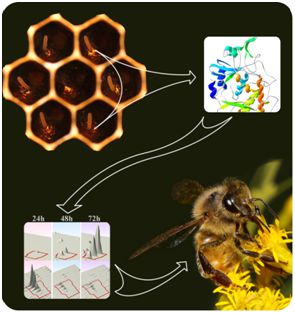分享到
Breakthrough in the mechanismic study of honeybee embryogenesis
 Honeybees provide us with honey, royal jelly, pollen, propolis and beeswax and support the ecological structure of the environment by transferring pollen between plants. Despite their ecological and economic importance, very little is known about how honeybee workers develop as embryos into the adult stage at the molecular level.
Honeybees provide us with honey, royal jelly, pollen, propolis and beeswax and support the ecological structure of the environment by transferring pollen between plants. Despite their ecological and economic importance, very little is known about how honeybee workers develop as embryos into the adult stage at the molecular level.The research group found that while there is a central set of proteins involved in common biological pathways to drive development, “embryos at different developmental stages have their own specific proteome and pathway signatures,” says Dr. Li Jianke, a senior scientist at the Bee Research Institute (BRI) of Chinese Academy of Agricultural Science (CAAS). “These findings provide a vital resource as a starting point for further functional analysis and genetic manipulation for both the honeybee embryos and other eusocial insects, such as wasps, ants and termites”.
The investigators studied the worker bees, which are responsible for building the honeycomb, cleaning it, defending the colony, foraging nectar and feeding the larvae. The worker bees, all sterile females, rise out of fertilized eggs in four stages. The first stage is the egg during which the body plan of the insect is established. Li and colleagues used liquid chromatography combined with mass spectrometry as well as bioinformatics to see what proteins were present and how expression changed in embryos during their 72-hour lifecycle.
The investigators found that the core proteome of all stages of embryonic development consisted of proteins involved in protein synthesis, metabolic energy generation and consumption, development, and molecular transporters. But each embryonic stage had specific sets of proteins turned up on top of the core proteome.
Embryos younger than 24 hours had more proteins involved in nutrient storage and nucleic acid metabolism which could correlate with the cell proliferation that happens at the early stage. Embryos during the 24-to-48-hour span expressed proteins responsible for cell cycle control, transporters, antioxidant activity and the cytoskeleton. These proteins may be present to support early formations of organs. The late-stage embryos, during the 48-to-72-hour time frame, produced proteins implicated in fatty acid metabolism and morphogenesis. These proteins could be responsible for the final formation of organs.
The study gives researchers an idea of the processes happening at the different stages of embryonic development. Scientists now can use the data to see if particular processes lend themselves well to creating genetically modified honeybees, an active area of research.
The research result was published online on June 3 in the Molecular & Cellular Proteomics. More details are available on the bellow links:
http://www.mcponline.org/content/early/2014/06/03/mcp.M114.037846.abstract
By Diao Qingyun
dqyun1@126.com
Latest News
-
 Apr 18, 2024Opening Ceremony of the Training Workshop on Wheat Head Scab Resistance Breeding and Pest Control in Africa Held in CAAS
Apr 18, 2024Opening Ceremony of the Training Workshop on Wheat Head Scab Resistance Breeding and Pest Control in Africa Held in CAAS -
 Apr 03, 2024IPPCAAS Co-organized the Training Workshop on Management and Application of Biopesticides in Nepal
Apr 03, 2024IPPCAAS Co-organized the Training Workshop on Management and Application of Biopesticides in Nepal -
 Mar 28, 2024Delegation from the School of Agriculture and Food Science of University College Dublin, Ireland Visit to IAS, CAAS
Mar 28, 2024Delegation from the School of Agriculture and Food Science of University College Dublin, Ireland Visit to IAS, CAAS -
 Mar 25, 2024Director of World Food Prize Foundation visited GSCAAS
Mar 25, 2024Director of World Food Prize Foundation visited GSCAAS -
 Mar 20, 2024Institute of Crop Sciences (ICS) and Syngenta Group Global Seeds Advance Collaborative Research in the Seed Industry
Mar 20, 2024Institute of Crop Sciences (ICS) and Syngenta Group Global Seeds Advance Collaborative Research in the Seed Industry
